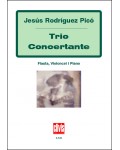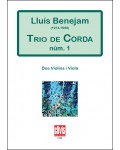
No products
Prices are tax included
Product successfully added to your shopping cart
There are 0 items in your cart. There is 1 item in your cart.
- English
- Castellano
- Català
Trios There are 38 products.
-
Trio Concertante
Edition: DigitalThe Trio Concertante is divided into three conventional movements. A theme, sad and meditative in character, appears at the beginning which is later repeated at different points in the work. Apart from these brief passages, the instrumental treatment is virtuoso and rhythmic in nature.
11,39 € -
String trio no. 1
Edition: DigitalIn his String Trio No. 1 (1956) Lluís Benejam plays with the sounds of two violins and a viola from a classical premise yet with a modern spirit.
18,15 € -
Trio en Mi
Edition: DigitalTrio en mi by Joaquim Serra has a very classical structure as a whole and in the form of each movement: at the first place Sonata, Song at the second place, and Rondó at the third.
20,67 € -
Trio no. 1 Op. 3
Edition: DigitalTrio for violin, cello and piano no. 1 by Lluís Benejam is structured into four movements, has a duration of nearly twenty minutes and an optimistic, romantic feel.
33,00 € -
Trio núm. 3
Edition: PrintedThe piece Trio núm. 3 is rather lengthy and is playful with the tonalities of the three main instruments from the saxophone family: with the piano ever-present, the first movement requires an alto and a tenor saxophone, the second a tenor and a baritone, and the third a duet of altos.
13,67 € -
Trio for trumpet, sax and piano 1967
Edition: DigitalLluís Benejam’s music flows forth from an open and vivacious spirit, susceptible to different influences. His work includes reminiscences of impressionism and jazz, incorporated in a personal way of understanding music:
13,92 € -
Miniatures 4
Edition: DigitalThe Miniatures are small pieces for small groups (from duets, trios and quartets to groups of eleven players) which explore the possibilities of the performers from the perspective of sound rather than technique or virtuosity.
6,35 € -
-
Miniatures 2
Edition: DigitalThe Miniatures are small pieces for small groups (from duets, trios and quartets to groups of eleven players) which explore the possibilities of the performers from the perspective of sound rather than technique or virtuosity.
7,27 € -
Miniatures 3
Edition: DigitalThe Miniatures are small pieces for small groups (from duets, trios and quartets to groups of eleven players) which explore the possibilities of the performers from the perspective of sound rather than technique or virtuosity.
6,66 € -
-













